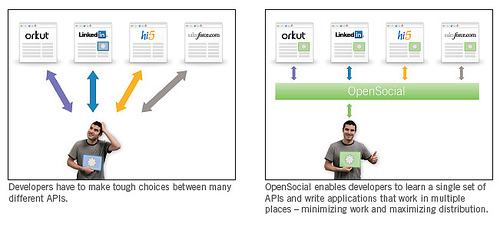Open standards: Break down those walls
On the Web, a walled garden is an environment that controls the user’s access to Web content and services. In effect, the walled garden directs the user’s navigation within particular areas, to allow access to a selection of material, or prevent access to other material.
Recent history suggests that open standards will again better the “walled gardens” of the WebPermalink to section titled Recent history suggests that open standards will again better the “walled gardens” of the Web
In 1994, when the previously obscure computer network, developed by the American Department of Defence, first become known to the general public as the “World Wide Web”, or simply The Web, many people first connected to it via AOL and CompuServe. These subscription-based service providers offered not only access to the Internet, but other services such as email, chatrooms, discussion boards and more. It was access to the Web via the Internet that would lead to the undermining of these services, and the opening up of the Web as a platform for individual and creative expression, revenue generation and social interactivity.
Whilst it took some time for the closed communities to venture out into the wilds of the Web, it brought about the standardisation of the services that made up the early web. For instance, POP and SMTP standardised email and as a result it has become the ubiquitous tool of business. Today, of the early pioneers of the Web, only AOL survives, but as an entirely different entity; a web portal supported by advertising.
History appears to be repeating itself. The biggest online phenomena of the past couple of years, the social-networking websites of Facebook and MySpace, are acting very much like the AOL of the mid-1990s. They are closed systems based upon prioprietory standards. You cannot easily move information from one system or another if you so choose. This ties users into one system, or forces them to create profiles on both. A similar comparison can be drawn with the virtual worlds of Second Life and Entropia Universe.
The Web is better when it’s socialPermalink to section titled The Web is better when it’s social
Part of the reason these websites are popular is because they are closed communities, where users can interact with friends and find new friends with which to interact. This community feel has been tested in recent times, with sites such as Facebook being criticised for using their user’s personal data to target advertising. It is inevitable, however, that these systems are proprietary; it is only once these systems immerse and become popular that standards can be developed and implemented.

Just as the Web’s open standards, embodied in the Netscape browser, displaced the online services providers, so the paradigm of open standards awaits the social networking and virtual worlds. Back in the 1990s it was Netscape, but in the 21st Century it falls to Google to defend the open standards of the Web with the Open Social API. Some say there is a large amount of self interest in this move, since Facebook and MySpace have huge communities, which both networks know a huge amount more about than Google and can hence generate billions of dollars of revenue.
The web is more interesting when you can build applications that easily interact with your friends and colleagues. But with the trend towards more social applications also comes a growing list of site-specific APIs that developers must learn. Open Social is an attempt not only to open up the closed communities and allow developers to interact with the different networks, but allow developers to only learn one API. MySpace has signed up to this initiative and, more reluctantly so has Facebook. A curiosity is AOLs recent aquisition of Bebo, another online community popular in Europe. Is AOL simply jumping on the “band-wagon”? Has it learnt its lessons of the past, or is it using knowledge of its past as a guiding principle? Whatever is the answer, Bebo’s inclusion in Open Social will help it continue its competition with other social networking websites.
On the Web, a walled garden is an environment that controls the user’s access to Web content and services. In effect, the walled garden directs the user’s navigation within particular areas, to allow access to a selection of material, or prevent access to other material.
Updated on: 22 March 2021